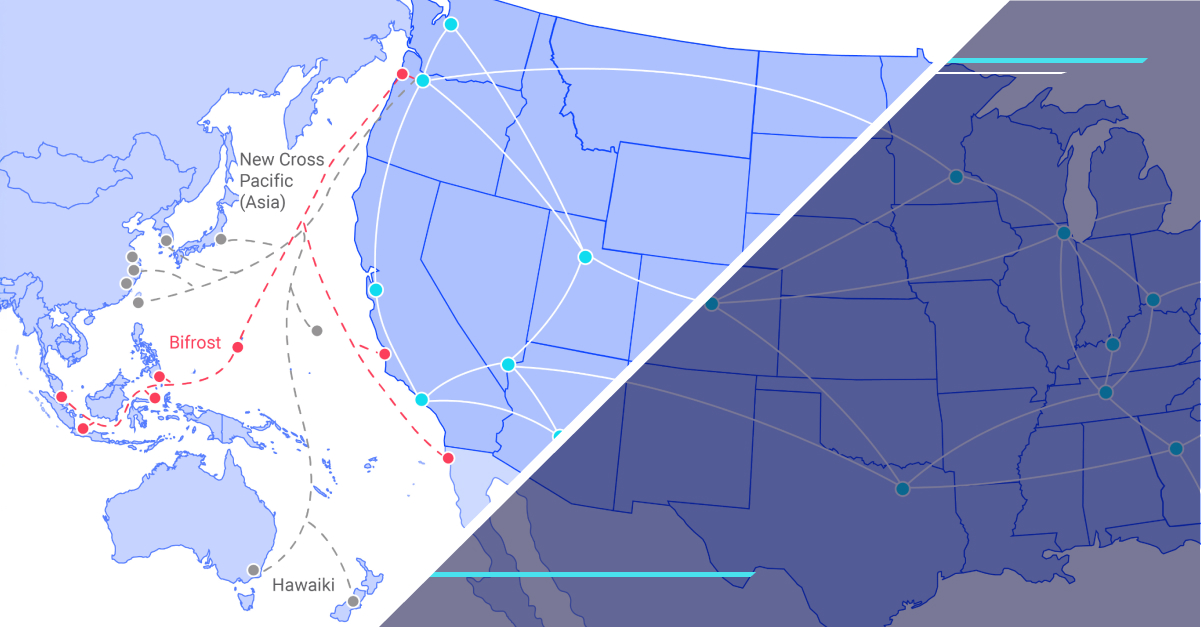Cross connects vs virtual cross connects
Cross connect technology has long been the standard way to link networks inside a data center, giving enterprises direct, private connectivity between carriers, clouds, and partners. But as workloads spread across multiple clouds and demands shift faster than ever, many organizations are turning to the next evolution: the virtual cross connect (VXC). A VXC offers the same security and performance, with the added advantage of software-defined flexibility. Instead of waiting days or weeks for physical cabling, you can spin up, scale, or retire connections in minutes.

For IT leaders and cloud architects, the difference goes beyond technology. It’s about keeping pace with hybrid IT and multicloud strategies while managing cost, security, and resilience.
What is a cross connect?
A cross connect is a direct, physical connection between two networks inside a data center. By bypassing the public internet, it delivers low latency, predictable performance, and stronger security for critical workloads. Organizations have relied on cross connects for decades to link their infrastructure with carriers, cloud providers, and partners in a controlled, high-performance environment.
For a deeper look at how traditional cross connects support digital performance, see our blog on Flexential cross connect.
What is a virtual cross connect (VXC)?
A virtual cross connect (VXC) extends the idea of a physical cross connect into a software-defined service. Instead of waiting on technicians to provision physical cabling, you can establish a secure, private link between networks on demand. VXCs give you the same performance and reliability of a traditional cross connect, but with the speed and flexibility that hybrid IT and multicloud environments demand.
How VXCs work
VXCs are provisioned through a digital platform rather than physical infrastructure changes. Using an online portal or API, you can:
- Choose the endpoints you want to connect (cloud providers, carriers, or enterprise systems).
- Define the bandwidth and terms of the connection.
- Activate or scale the connection in near real time.
Because they’re virtual, VXCs let IT teams move as quickly as the business requires—whether that means spinning up temporary test environments, scaling bandwidth for seasonal traffic, or connecting to a new partner without delay.
Key differences from traditional cross connects
While both cross connects and VXCs deliver private, high-performance connections, their operational models are very different:
| Feature | Cross connect | Virtual cross connect (VXC) |
| Provisioning | Manual cabling, often takes days or weeks | Software-defined, minutes to hours |
| Scalability | Fixed, requires new cabling for changes | Elastic, bandwidth can be adjusted on demand |
| Flexibility | Static, point-to-point | Dynamic, multiple clouds, carriers, and partners |
| Use cases | Long-term, stable connections | Hybrid IT, multicloud, DR, partner access |
Benefits of virtual cross connects
A virtual cross connect (VXC) isn’t just a modern replacement for cabling. It’s a strategic tool that gives IT leaders the ability to move faster, scale smarter, and support complex hybrid IT architectures with less friction.
Speed and agility
Traditional cross connects often require long lead times for provisioning and change management. VXCs eliminate that bottleneck. You can spin up, adjust, or retire connections in minutes, allowing your infrastructure to respond immediately to new workloads, customer demand, or partner requirements. This agility keeps your business competitive in a digital environment where waiting weeks for a new connection simply isn’t an option.
Multicloud and hybrid IT enablement
Most enterprises now run workloads across multiple public clouds, private infrastructure, and colocation facilities. VXCs make that complexity manageable by providing a unified way to interconnect environments. Instead of juggling separate contracts or relying on the public internet, VXCs deliver direct, private connectivity between cloud providers, carriers, and your own data center resources, forming the backbone of true multicloud and hybrid IT infrastructure.
Cost efficiency & scalability
Because VXCs are software-defined, you only pay for what you use. Need to increase bandwidth for a seasonal peak? Scale up instantly. Done with a temporary test environment? Scale down just as easily. Avoiding the cost of underutilized capacity—and the time and labor of physical cross connects—helps you keep budgets predictable while matching network resources to business demand.
Security and compliance
Like physical cross connects, VXCs bypass the public internet to ensure data travels over private, controlled paths. This reduces exposure to threats and supports compliance with industry regulations. For organizations in healthcare, finance, or other regulated industries, VXCs provide the combination of security, auditability, and flexibility needed to keep sensitive workloads protected while maintaining operational agility.
Use cases for VXCs
Virtual cross connects (VXCs) shine when speed, flexibility, and private connectivity are essential. Here are some of the most common enterprise scenarios where VXCs deliver real value.
Data center interconnect
Enterprises often need to link workloads across multiple facilities. With VXCs, you can create a secure, private bridge between sites without the delays of physical cabling. That makes them a natural extension of a data center interconnect strategy, ensuring your infrastructure performs consistently across locations.
Multicloud interconnection
Most IT teams are balancing services from AWS, Azure, Google Cloud, and private infrastructure. VXCs make that possible by delivering consistent, low-latency links between providers through a single digital interface. Instead of relying on public internet connections or multiple carrier agreements, VXCs give you a direct path to the cloud resources that matter most, supporting true interconnection capabilities across your hybrid IT environment.
Rapid partner connectivity
From SaaS providers to supply chain partners, businesses frequently need fast, secure connections to external organizations. A VXC lets you provision that connectivity on demand, so you can move projects forward without waiting weeks for traditional cross connects. This flexibility supports models like bring your own carrier (BYOC), where enterprises choose the providers and partners that best fit their strategy.
Disaster recovery/business continuity
When disaster strikes, every minute counts. VXCs enable rapid provisioning of alternate paths to replicate data, reroute traffic, or connect to backup sites. Supported by strong IT infrastructure management, this agility helps organizations maintain uptime and meet compliance standards for business continuity while keeping performance intact.
How Flexential delivers VXCs
Flexential delivers virtual cross connects (VXCs) through the FlexAnywhere platform, a unified suite that brings colocation, cloud, interconnection, and data protection together to support hybrid IT at scale.
FlexAnywhere platform and interconnection services
At the core is Flexential Fabric, our software-defined interconnection layer. From a single port, you can automate private transport and virtual connections to services such as IP Bandwidth, Data Center Interconnect (DCI), and Cloud Fabric. VXCs are provisioned directly through the Flexential Xperience Portal (FXP) or API, giving IT teams near real-time control over bandwidth and paths.
Our interconnection footprint includes 40+ data centers across 19 metros, with access to more than 300 connectivity providers. Cross connects can also be ordered through FXP, streamlining the process and reducing lead times.
Recent enhancements expand what customers can do with VXCs:
- Interconnection Mesh: Enables multipoint, any-to-any connectivity across distributed environments, providing more redundancy and simplified management.
- Cloud Fabric: Delivers software-defined, private connections to leading cloud providers, helping organizations move beyond the public internet for faster, more consistent performance.
With these capabilities, Flexential makes VXCs not just faster to deploy but also easier to scale and manage as enterprise connectivity needs evolve.
Key takeaways: Why VXCs are the future of enterprise connectivity
VXCs represent the next phase of enterprise connectivity. By combining the private performance of a traditional cross connect with the agility of software-defined control, VXCs give IT leaders the flexibility to adapt quickly, scale with confidence, and support increasingly complex hybrid IT and multicloud strategies.
As security, compliance, and cost pressures mount, VXCs provide a future-ready foundation that helps enterprises stay connected without compromise. And with the FlexAnywhere platform and Flexential Fabric, organizations can provision and manage these connections in real time, backed by one of the most comprehensive interconnection portfolios in the industry.
Explore Flexential network solutions and contact our team to see how VXCs can support your strategy.
FAQs about virtual cross connects
What is the difference between a cross connect and a virtual cross connect?
A cross connect is a physical cable inside a data center that links two networks directly. A virtual cross connect (VXC) provides the same private, low-latency performance but is software-defined, so you can provision or adjust connections in near real time without waiting for physical cabling.
How does a virtual cross connect work?
VXCs are provisioned through a digital platform like the Flexential Xperience Portal (FXP). You select the endpoints you want to connect, such as cloud providers, carriers, or your own infrastructure, and the system establishes the private connection automatically.
Why are VXCs important for multicloud networking?
Most enterprises use a mix of cloud providers and private infrastructure. VXCs simplify this by creating secure, on-demand links between environments. This allows you to manage hybrid IT and multicloud strategies with greater agility and less reliance on the public internet.
Are virtual cross connects more secure than traditional cross connects?
Both options offer private connectivity that bypasses the public internet. The difference is that VXCs add flexibility and faster provisioning without sacrificing security, making them well-suited for compliance-driven industries like healthcare or finance.
What use cases are best suited for VXCs?
VXCs are ideal for connecting data centers, enabling multicloud interconnection, establishing rapid partner links, and supporting disaster recovery or business continuity strategies. They give you the flexibility to stand up new connections quickly and scale them as business needs change.




